
Alois ŠIŠKA
311 Sqn pilot
..* 15.05.1914, Lutopecny, Czechoslovakia.
..† 09.09.2003, Prague.
One man’s struggle against Nazi tyranny, the elements and Communism
Jeden z mužů, kteří bojovali proti nacistické tyranii, s přírodními živly a komunistickou nenávistí
Před válkou: Pre WW2:
Alois Šiška was born at Lutopecny, near Kroměříž, in the Moravia region of Czechoslovakia, on 15 May 1914. His parents had a smallholding and Alois was the youngest of their three children. He never knew his father who had become one of the casualties of WW1, being killed on the Russian front in 1915.
Alois Šiška se narodil v Československu, na Moravě v obci Lutopecny u Kroměříže, 15. května 1914, jako nejmladší ze tří dětí. Rodiče vlastnili malou farmu. Otce nikdy nepoznal, neboť se stal obětí 1. světové války. V roce 1915, přišel o život na ruské frontě.
Baťa:
From an early age Alois became interested in flying, initially building model aircraft and on completion of his schooling he trained to be a mechanic. Baťa, the shoe manufacturer at nearby Zlin, was the main employer in the region and in addition to factories there also had an Engineering College there for the training of their employees. Alois managed to get an apprenticeship with Baťa.
Od útlého věku se Alois zajímal o létání. Z počátku stavěl modely letadel a po ukončení základní školní docházky se vyučil jako automechanik. Baťa ve Zlíně byl hlavním zaměstnavatelem v regionu a kromě továren na obuv měl vysokou školu a učební zařízení pro vzdělávání svých zaměstnanců. Alois měl štěstí a byl přijat do učení u Bati.
Tomas Baťa the head of the family firm, the firm expanded into aviation at their Otrokovice site building a small airfield there from where the companies aircraft would transport goods and fly key personnel to the various Baťa. In 1934, Baťa obtained a license to build light aircraft and Alois was one of the employees working on this new project.
Tomáš Baťa byl v čele rodinné firmy, která kromě výroby obuvi se začala zabývat leteckou dopravou a v Otrokovicích budovala malé letiště, z něhož by podniková dopravní letadla přepravovala zboží a klíčové zaměstnance do různých Baťových podniků. V roce 1934 Baťa získal licenci na stavbu lehkých letadel a Alois Šiška byl jedním ze zaměstnanců zařazených do tohoto nového projectu.
The rise of Hitler in neighbouring Germany, who began to rebuild German military forces, was becoming a concern to the Czechoslovak Government, and they looked to strengthen their own forces. One of the initiatives to achieve this was the ‘1000 pilots for the Republic’ scheme whereby young men were selected to train as ’Sports’ pilots at local aero-clubs, this training to be financed from commercial sources in Czechoslovakia.
Vzestup Hitlera v Německu, který začal s výstavbou německých vojenských sil se stal problémem pro československou vládu, která začala posilovat obranu Československa. K dosažení tohoto cíle bylo jednou z iniciativ, “1000” pilotů republice, kdy byli místními leteckými kluby vybíráni k leteckému výcviku mladí muži. Školení bylo financováno z komerčních zdrojů v Československé republice.
This initiative was fully supported by Baťa who encouraged its employees to join the scheme; 250 of the required 1000 pilots were from Baťa sources. Alois was one of these pilots and gained his ‘Sports’ pilots licence in September 1936.
Tuto iniciativu plně podporovala firma Baťa povzbuzováním svých zaměstnanců, aby se v rámci této akce hlásili do leteckého výcviku. Z požadovaných 1000 nových pilotů republice, ze zdrojů Bati bylo vycvičeno 250 pilotů. Alois Šiška byl jedním z pilotů, který v září 1936, získal průkaz sportovního pilota.
Czechoslovak Air Force:
Československé letectvo:

Alois at Pilot School at 2nd Air ‘Dr Edvard Beneš’ Regiment, 1937.

Czechoslovak Air Force 1938.
Soon after, Alois then started his compulsory two-year military service and was selected to attend the Military Aviation College at Prostějov to undergo further pilot training. During his training, he was flying Aviva B-534 and then Aero AP-32 bi-planes. In March 1939, following the German annexation of Czechoslovakia, the Czechoslovak Air Force was disbanded and all personnel dismissed.
Brzy poté, Alois nastoupil na dva roky do armády na vojenskou povinou službu, kde byl vybrán do Vojenského leteckého učiliště v Prostějově, aby pokračoval v dalším pilotním výcviku. Během svého výcviku létal na letounech Avia B-534 a dvouplošníku Aero AP-32. Po německé okupaci Československa 15.března 1939, Českosloenské letecvo bylo rozpuštěno a většina leteckého personalu se s okupací nesmířila.
Occupation: Okupace:

German occupation of Czechoslovakia, 15 March 1939. / Německá okupace Československa, 15. března 1939.
Return to Baťa: Návrat k Baťovi:
Šiška returned to work at the Zlin Baťa aircraft company. He was involved in the development of a new prototype aircraft – the Zlin Z-XIII, an innovative fast single wing sports aircraft – and it was planned that it would be flown out of Czechoslovakia before the Germans could learn any of its technical features. Šiška was selected to be the pilot for this flight, however, at the last minute, the plan had to be aborted. Instead, the aircraft had its appearance changed and hidden away in a hanger.
Šiška se vrátil do společnosti Baťa ve Zlíně a podílel se na vývoji nového prototypu letadla – Zlín Z-XIII. Jednalo se o rychlou inovaci sportovního jenoplošníku a připraven byl plán, že odletí z Československa ještě předtím, než by se Němci měli možnost seznámit s některými novými technickými systémy. Šiška byl vybrán k vykonání tohoto letu, ale na poslední chvíli musel být plán odletu přerušen. Letadlu byl urychleně změněn vzhled a byl ukryt v hangáru.
A few months later Šiška, whilst at work, was warned that the Gestapo were looking for him. He feigned sickness and immediately went home and made rapid preparations to escape. Within an hour, accompanied by a friend, he was aboard a train to Hodonin which was near the Slovak border. They covertly crossed the border into the new fascist state of Slovakia and onto Hungary. In Hungary, they went to the French Consulate in Budapest, where they obtained assistance and documents. They were instructed to reach Yugoslavia where they would board a ship which would take them to France.
O několik měsíců později, byl Šiška v práci varován, že jej hledalo Gestapo. Začal předstírat, že onemocněl a okamžitě šel domů a urychleně se připravoval k útěku. Během hodiny, doprovázen přítelem nastoupil do vlaku do Hodonína, který se nachází v těsné blízkosti hranice se Slovenskem. Společně tajně překročili hranice nového fašistického státu Slovenska. Ze Slovenska přešli hranice do Maďarska, kde v Budapešti vyhledali francouzský konzulat a tam požádali o pomoc. Pomoc jim byla poskytnuta a dostali dokumenty a instrukce k dosažení Jugoslavie, kde měli nastoupit na loď a odjet do Francie.
Whilst attempting to cross the Hungarian border into Yugoslavia, they were arrested by Hungarian border guards and detained, eventually being imprisoned at the Citadel prison at Budapest. In a daring move, he managed to escape from the Citadel and reached the same French Consulate as previously. Again with their assistance, traveling with other Czech escapers, they successfully managed to cross into Yugoslavia. From here they traveled to Greece, where they boarded a ship which took them to Istanbul, Alexandria, Algeria and finally to Marseille, France.
Při snaze o překročení státní hranice mezi Maďarskem a Jugoslávii, byli zadrženi maďarskou pohraniční stráží a eskortováni do věznice v Budapešti, kde byli uvězněni. Z věznice se jim podařilo utéci a opět se vydali na francouzský konzulát. S jeho pomocí a spolu s dalšími českými uprchlíky se jim podařilo přejít hranice do Jugoslavie, z níž odcestovali do Řecka, kde nastoupili na loď, kterou pluli přes Istanbul, Alexandrii, Alžírsko do Marseillie ve Francii.
France:
Francie
In France he was initially at the Czechoslovak military transit camp at Agde. As a trained pilot he was selected to join l’Armee d’Air and sent for retraining onto French aircraft and also to learn French.
Ve Francii byli z počátku v československém vojenském tranzitním táboru Adge. Jako pilot s platným pilotním průkazem, byl vybrán a zařazen do l´Ármee d´Áir a vyslán k přeškolení na francouzká letadla a do jazykového kurzu francoužštiny.
The Germans invaded France on 10 May 1940. With their Blitzkrieg attack, they were rapidly advancing forward and France capitulated on 22 June 1940. At the time of the capitulation of France, Šiška was stationed at Mérignac airbase near Bordeaux. With other Czechoslovak airmen left Bordeaux on aboard the ‘Ary Schaeffer’, a Danish cargo ship, which was bound for England, arriving at Falmouth on 24 June.
Němci napadli Francii dne 10. května 1940. S jejich Blitzkrieg, překvapivým útokem, rychle postupovali kupředu a Francie kapitulovala 22. června 1940. V době kapitualce Francie se Šiška nacházel na letecké základně Merignac nedaleko Bordeuax. S dalšími československými letci opustili Bordeaux na palubě „Ary Schaeffer“, dánské nákladní lodi, která směřovala do Anglie a připlula do Falmouthu 24. června.
RAF:
In England, he was accepted into the RAF Volunteer Reserve. He was first transferred the Czechoslovak Depot at Cosford and then for retraining to Wellington twin-engined bombers and also learning some English. He was then posted, as a pilot, with the rank of Sgt, to the newly formed 311 Czechoslovak Squadron who were based at East Wretham, Norfolk.
V Anglii byl přijat do dobrovolnické rezervy RAF. Nejprve byl zařazen v Cosfordu do Československého Depot a potom byl přeškolen na dvoumotorové bombardéry Wellington a zařazen do kurzu angličtiny. Po přeškolení byl vyslán, jako pilot s hodností Sgt., do nově vytvořené 311. československé perutě, která byla umístěna na základně East Wretham, Norfolk.

Alois with fellow 311 Sqn pilots.
His first operational flight was on the night of 10/11 September 1940, a raid on the railway yard at Brussel. This was the first of the 19 operational missions that he flew with the squadron, targets were usually the Channel ports or ports in Germany.
Jeho první operační let se uskutečnil v noci 10/11.9.1940, na nádraží v Bruselu. Byla to první z operačních misí, kterých vykonal v peruti celkem 19. Obvyklými cíli byly Channel porty nebo přístavy v Německu.
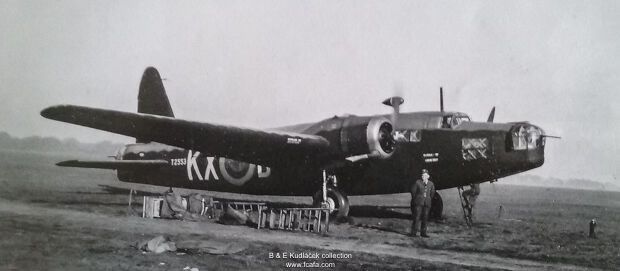
Wellington Ic KX-B, T2553, East Wretham.
On the night On the night of 26 December 1941, Šiška piloted a Wellington bomber, KX-B, T2553, on a raid to the German docks at Wilhelmshaven. His crew were Josef Tománek – co-pilot, Josef Ščerba – wireless operator/air gunner, Josef Mohr – navigator, Pavel Svoboda – front gunner, and Rudolf Skalický – rear gunner. Despite flak damage to his aircraft over the target, he completed his bombing run but on his return journey the port engine caught fire and eventually fell off causing the aircraft to ditch in the North Sea.
V noci z 26. na 27.prosince 1941, Šiška při náletu na německé doky u Wilhelmshaven pilotoval dvoumotorový bombardovací letoun Wellington, KX-B T2553 Jeho posádku letounu tvořili Josef Tománek – co pilot (druhý pilot), Josef Ščerba -rádiotelegrafista/střelec na vzdušné cíle, Josef Mohr- navigátor, Pavel Svoboda a Rudolf Skalický – střelci na vzdušné cíle. I přes ostrou kritiku v důsledku poškození letounu nad cílem, dokončil Alois Šiška nálet na cíl s odhozem pum. Při zpáteční cestě do Anglie motor začal hořet, letoun klesal až do malé výšky nad hladinou Severního moře a Šiška byl donucen k přistání na hladinu moře.
The force of the impact caused Šiška to be knocked out as his head struck the instrument panel. Fortunately, the rising water in the cockpit revived him and he was able to climb out onto the port wing from where, despite a rough sea, the other four surviving crew members managed to rescue him in a dinghy. The rear gunner Rudolf Skalický did not survive the crash and went down with the aircraft.
Při dosednutí letounu v noci na rozbouřenou hladinu došlo k prudkému zbrždění letounu a Alois Šiška narazil hlavou do přístrojové desky a ztratil vědomí. Stoupající voda v kabině jej oživila a po uvolnění popruhů od sedadla vystoupil na levé křídlo, kde se osádce letounu podařilo nastoupit do malého člunu. Zadní střelec Rudolf Skalický náraz letounu na vodní hladinu nepřežil a potopil se s letounem do moře.

Wellington Ic KX-B, T2553.
During the night, their desperate plight was further compounded when a floating sea mine narrowly missed them and their signals failed to attract passing ships. On New Years Day a seagull was sighted which indicated that they were close to land, in desperation one of the crew suggested to try and catch and kill the seagull so that they could drink its blood, but by now they were all too weak to undertake this task.
V noci jejich svízelná situace byla umocněna tím, že plovoucí lodě nedaleko člunu nezachytily jejich signály. Na Nový rok viděli racka, který byl důkazem, že pevnina není daleko. Jeden člen osádky člunu v zoufalství navrhl, že by měli racka chytit,. zabít jej a napít se jeho krve. Všichni byli natolik zesláblí, že racka chytit nemohli.
The following day Mohr and Tománek died from exposure and Ščerba was drifting in and out of consciousness. It was a desperate situation and Šiška and Svoboda decided to end their suffering by taking the drugs from the medicine box. The drugs washed down with seawater, failed to achieve the desired result. Now, in a semi-conscious state they realised that the dinghy was now full of water and in danger of sinking.
Následující den Mohr a Tománek zemřeli před svítáním a Ščerba byl stále v bezvědomí. Byla to zoufalá situace a Šiška se Svobodou se rozhodli ukončit své utrpení tím, že polknou léky z medicíny a zapijí je mořskou vodou. Nepodařilo se jim dosáhnout očekávaného výsledku. Nyní, při částečném vědomí si uvědomili, že člun je nyní plný a hrozí nebezpečí jeho potopení.
Šiška and Svoboda realised that the only thing they could do to save themselves was to tip their two dead comrades into the sea. With great difficulty, due to their weakened state, they managed to get Tománek’s body out of the dinghy and watched it as it sank beneath the waves of the North Sea.
Šiška a Svoboda si uvědomili, že jedinou věc, kterou mohou učinit, aby se zachránili, musí své dva mrtvé kamarády dát do moře. Vzhledem k jejich fyzickému stavu oslabení se jim podařilo s velkou námahou dát tělo Tománka z člunu do moře a sledovali, jak se potopil pod hladinu Severního moře.
They tried to push Mohr’s body out of the dinghy but were too weak to do so. With Ščerba now unconscious, Šiška and Svoboda could only await for what fate would deliver them.
Snažili se vytlačit z člunu take tělo Mohra, ale již neměli dostatek sil. Ščerba byl stále v bezvědomí a Šiška se Svobodou již mohli čekat jen na osudovou šťastnou náhodu.
The three survived the night. The following morning, Svoboda saw land. Later that day, after six days in the dinghy, they were washed ashore onto the Dutch coast, at Petten, near Bergen am Zee. German soldiers had watched the dinghy approach the shore and the three surviving members of Wellington KX-B were taken prisoner by them.
Všichni tři přežili noc. Druhý den ráno uviděl Svoboda zemi. Ještě ten den,po šesti dnech ve člunu, byl jejich člun vyplaven na holandské pobřeží u Pettenu nedaleko Bregen am Zee. Němečtí vojáci sledovali vyplavení nafukovacího člunu na břeh s třemi přeživšími členy osádky Wellingtonu KX-B a vzali je do zajetí.
The body of Mohr was later washed up on the Dutch coast and is buried at the Bergen General Cemetery, Bergen – Noord-Holland. Tománek’s body was never found and he is remembered on panel 53 at the Runnymede Memorial.
Tělo Mohra bylo později vyplaveno na holandské pobřeží a je pohřben na hřbitově Bergen General, Bergen – Noord-Holland. Tománkovo tělo nebylo nikdy nalezeno a jeho jméno je uvedeno panelu 53 v památníku Runnymede.
This six-day epic had resulted in Šiška having his legs frostbitten and gangrene had set in. The Germans took him initially to the nearby Alkmaar Naval hospital from where he was transferred to a military hospital in Amsterdam. Here the surgeons decided to amputate his legs but as Šiška was put on the operating table he had a heart attack.
Tento šestidenní strastiplný pobyt na člunu v zimním období způsobil, že Alois Šiška měl omrzlé nohy a gangrénu. Němci jej neprve převezli do nedaleké námořní nemocnice Alkmaar, odkud jej přepravili do vojenské nemocnice v Amsterdamu, kde se nejprve chirurgové rozhodli amputovat mu nohu. Když Aloise Šišku dali na operační stůl dostal iinfarkt.
The amputations had to be abandoned and alternative methods of trying to save his legs where attempted which were partially successful. Some six months later Šiška was moved to the first of several prison camps in Germany where he was confined until July 1944 when the Gestapo sent him to Prague.
Od amputace nohou muselo být upuštěno a hledaly se alternativní metody léčby, které by zachránily nohy, některé z nich byly částečně úspěšné. Asi za šest měsíců léčby byl Alois Šiška umístěn do prvního z několika vězeňských táborů v Německu, kde setrval až do července 1944, kdy jej Gestapo převezlo do Prahy.
Czechoslovakia had, since the German annexation, been declared a ‘protectorate’ of the Reich. Czech citizens were classed as citizens of the Reich and those Czechoslovaks who fought against the Reich were deemed to be traitors against the Reich. Siška was charged with high treason and espionage and sent to Colditz castle awaiting Court Martial and possibly execution. Fortunately for Šiška, the July Bomb Plot had just taken place against Hitler and the Gestapo’s attention was distracted to deal with that. By the time they re-focused their attention to Šiška the Red Cross had managed to intervene and ruled that the Czechs in the RAF were considered to be British for the duration of the war.
Po obsazení zbytkového území Čech a Moravy bývalé Československé republiky 15. března 1939 Němci, bylo toto území vyhlášeno protektorátem Velkoněmecké Říše (Protektorát Čechy a Morava) a Češi a Moravané byli považováni za německé občany. Češi a Moravané bojující proti Německu byli považováni za vlastizrádce. Alois Šiška byl obviněn z velezrady a špinonáže a byl převezen na hrad Colditz, kde čekal na soudní přelíčení válečného Soudu. Bombový útok na Hitlera však odvrátil pozornost Gestapa jiným směrem. V té době se Červenému kříži podařilo zasáhnout a bylo rozhodnuto, že Češi ve službách RAF byli považováni po dobu trvání války za Brity.
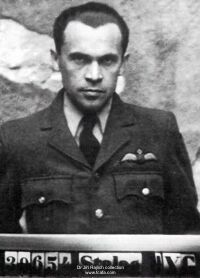
Alois Šiška, prisoner 39654
He was incarcerated in Colditz for ten months and the day before the camp was liberated by American troops he was moved to another prison camp. Fortunately it was only a few days before this camp was liberated by a column of American tanks.
V Colditz byl uvězněn deset měsíců a den před osvobozením americkou armádou byl přemístěn do jiného vězeňského tábora. Naštěstí to bylo jenom několik málo dní předtím, než tento tábor osvobodily americké tanky.
Initially he was transferred to Brussels and then on his 31st birthday to RAF Cosford on his journey to the Sir Archibald McIndeo’s burns and plastic surgery unit at the Queen Victoria Hospital, East Grinstead. He was there for two years as he underwent treatment to try and recover the partial use of his legs.
Z počátku byl přemístěn do Bruselu a pak po oslavě 31. narozenin s RAF Cosford odjel do lečebného ústavu popálnin a plastické chirurgie sira Archibalda Mcindeo na Queen Victoria Hospital, East Grinstead. Zde podstoupil dvouletou lečbu nohou, aby se alespoň částečně obnovila jejch funkce.

With fellow Guinea Pigs at Queen Victoria Hospital, Autumn, 1945. / S ostatními morčaty v nemocnici královny Viktorie, podzim 1945.
Šiška then returned to Czechoslovakia. By then the initial euphoria shown to the returning Czechoslovak RAF servicemen was being undermined by the rising Communist indoctrination. In Spring 1948, following the Communist putsch, they systematically pursued a program to demean the ex RAF servicemen as they were considered to be tainted with capitalism. In Šiška’s case he was prevented from returning to England and completing his treatment. On 1 February 1950 he was dismissed from the Czechoslovak Air Force, forced to leave Prague and was only allowed to be employed in menial work.
Alois Šiška se pak v roce 1947 vrátil do Československa. V té době se již prokázalo, že počáteční eufórie návratu československých letců RAF a příslušníků obrněné brigády v roce 1945 byla značně ohrožena komunistickou propagandou. Na jaře 1948 po komunistickém puči se systematicky a programově ponižovali bývalí příslušníci RAF, neboť byli považováni za infikované kapitalistickým způsobem života a tudiž nebezpečné pro budování socialismu. Šiškovi bylo bráněno k návratu do Anglie k dokončení léčby. Dne 1.února 1950 byl propuštěn z Československého letetctva a musel opustit Prahu a povolena mu byla pouze podřadná práce.
In 1949 Šiška married Vlásta Procházková but she was prevented from completing her University education – just a month before her graduation and they were sent to live on a collective farm in a remote country district. He was now disabled and living on a small pension which the Communists periodically reduced to cause them more hardship. He was now not allowed to work but taught himself to repair wireless sets, watches and progressed later onto television sets. Their daughter Dagmar was born in 1952.
V roce 1949 Alois Šiška uzavřel manželství s Vlastou Procházkovou která měla za měsíc ukončit studium na vysoké škole. Oba však byli vysídleni do vzdálené obce, kde museli pracovat zemědělském družstvu. Alois Šiška byl zdravotně postižený z války a byl mu přiznán malý důchod, který komunisté pravidelně snižovali a tak jim způsobovali stále větší životní problémy. Protože nesměl pracovat, naučil se opravovat rádiové přijímače a hodinky. Později se naučil opravovat televizní přijímače. Dcera Dagmar se narodila v r. 1952.
During 1961, Šiška and his family were permitted to move closer to Prague. In 1963 he was called to be a witness at the trial of the Nazi lawyer Hans Globke which was held in East Berlin. In 1944 Globke had been instrumental with Šiška being charged with treason. A positive outcome of this trial was that it drew attention, throughout Europe, to the suffering the Czechoslovak RAF pilots had endured since 1948 and this subsequently led to a gradual easing of the restrictions they had endured.
V roce 1961 bylo jim povoleno přestěhovat se blíže ku Praze. V roce 1963 byl povolán k soudnímu procesu který se konal ve východním Berlíně s nacistickým právníkem Hansem Globke, který v roce 1944 pomáhal při obviňování Aloise Šišky ze zrady Velkoněmecké Říše. Kladem tohoto soudního přelíčení bylo, že upozornilo veřejnost v celé Evropě na utrpení českých a moravských pilotů bojujících za války na straně spojenců v RAF a obnovení tohoto utrpení po roce 1948 v Československu, což následně vedlo k postupnému uvolňování jejich omezení ve společnosti.
This easing of restrictions enabled Šiška, by 1966, to be employed by ČSA, the Czechoslovak National Airline, as a Security and Fire inspector. Following the ‘Prague Spring’ of 1968, he was reinstated back into the Czechoslovak Air Force. Sadly history was about to repeat itself and following Russian invasion of Czechoslovakia, in 1968, to re-establish their authority following the ‘Prague Spring’, Šiška was once again dismissed from the Czechoslovak Air Force and banished from Prague.
Toto uvolnění v omezování letců RAF umožnilo přijetí Aloise Šišku do zaměstnání v ČSA (Československé národní letecké společnosti), na funkci požárního a bezpečnostního inspektora. V roce 1968 v období ‘pražského Jara,’ byl opět přijat do služby v Československém vojenském letectvu. Po Ruské invazi do Československa v srpnu 1968, byl opět z Československého vojenského letectva propuštěn a donucen vystěhovat se s rodinou z Prahy.

Alois Šiška with Goldfish Club badge on uniform, Kbely, 1991. / Alois Šiška s odznakem Klubu zlaté rybky na uniformě, Kbely, 1991.
This remained the position for nearly 20 years and he was only able to return to Prague shortly before the ‘Velvet Revolution’ in 1989 when the Communist regime collapsed in the Eastern Bloc countries. In the RAF rehabilitation ceremony held at the Palác Kultury in Prague on 13 September 1991, he was promoted to the rank of Major General in the Czechoslovak Air Force. On 4 November 2008, the Czech Air Force 222nd training squadron was named ‘ŠIŠKOVA’ in his honour.
Tato situace trvala téměř 20 let a Alois Šiška se mohl s rodinou vrátit do Prahy krátce před ‘sametovou revolucí’ v roce 1989, kdy se zhroutil komunistický režim v zemích východního bloku. Ve slavnostním obřadu rehabilitace příslušníků RAF, který se konal v Paláci kultury v Praze dne 13. září 1991 byl Alois Šiška povýšen do hodnosti generálmajora československého letetcva. Dne 4.listopadu 2008, byla k poctě Aloise Šišky nazvána: 222. školní peruť českého letectva “Šiškova”.
During his final years he spent time lecturing Czech schoolchildren on his wartime experiences and regularly attended reunions of the Guinea Pig Club – all former patients of Sir Archibald McIndoe at Queen Victoria Hospital, East Grinstead, where he was the last Czech member. Just three week before he died he made his first return to the infamous Colditz Castle.
V posledních letech svého života přednášel a besedoval se žáky škol, kde je seznamoval se svými zážitky z války a pravidelně navštěvoval setkání na Guinea Pig Club (Klub morčat)- všech bývalých pacientů sira Archibalda McIndeo na Queen Victoria Hospital, East Grintead, v němž byl posledním českým členem. Pouhé tři týdny před svou smrtí poprvé navštívil neslavný Colditz hrad.
He was awarded the Milan Rastislav Štefánik Order 3rd class in 1991. He died peacefully in his sleep on 9 September 2003 and six weeks later, on 28 October 2003, he was awarded, in memoriam, the Class III Řád bilého lva [Military Group] the Order of the White Lion – the highest Czech military decoration.
V roce 1991 dostal řád Milana Rostislava Štefánika III. třídy. Zemřel klidně ve spánku dne 9. září 2003 a o šest týdnů později, dne 28. října 2003 mu president České repubiky udělil Řád Bílého Lva III. třídy, nejvyšší české vojenské vyznamenání.
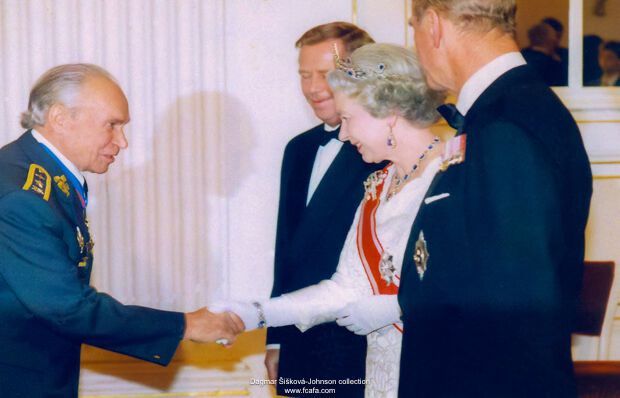
With President Vaclav Havel, Queen Elizabeth II and Duke of Edinburgh, March 1996, Prague. / S presidentem Havlem, královnou Alžbětou II a vévodou z Edinburgu, Praha, březen 1996.
_______________________________________________________________
Medals: Medaile:
_______________________________________________________________
Válečný kříž 1939 [Czechoslovak War Cross 1939] and 3 bars
Za chrabrost před nepřítelem
Za zásluhy 1. stupně
Pamětní medaile se štítky F–VB
_______________________________________________________________
1939 – 45 Star
Air Crew Europe Star
War Medal 1939 – 1945
Defence Medal
_______________________________________________________________
Post WW2, he was awarded:
Orden Krasnoi Zvezdy [Order of the Red Star] – 1964
Kríž Milana Rastislava Štefánika III. Class [Cross of Milan Rastislav Štefánik Class III] – 1991
Class III Řád bilého lva [White Lion, Military, Class III] – 2003
Záslužný kříž ministra obrany České republiky I. Class [Cross of Merit of the Minister of Defense of the Czech Republic, I Class] – 2003
_______________________________________________________________
Remembered: Pamětní místa:
_______________________________________________________________
Czech Republic: Česká republika:
_______________________________________________________________
Lutopecny:
He is remembered on a Memorial Plaque at his former home at Lutopecny.
Jeho památku připomíná pamětní deska v Lutopecnách, kde se narodil.

_______________________________________________________________
Otrokovice:
A memorial plaque was unveiled in 2007, at Otrokovice – Kvítkovice, where he lived whilst working at Baťa, pre WW2.
V r: 2007 mu byla odhalena pamětní deska v Kvítkovicích u Otrokovic, kde žil v době svého působení u Baťi před vypuknutím 2.sv.v.

_______________________________________________________________
Prague 1 – Klárov:
In November 2017, his name, along with the names of 2507 other Czechoslovak men and women who had served in the RAF during WW2, was unveiled at the Winged Lion Monument at Klárov, Prague 1.
V listopadu 2017 bylo jeho jméno, spolu se jmény dalších 2 512 československých mužů a žen, kteří sloužili v RAF během 2. světové války, odhaleno na desce Pomníku Okřídleného lva na pražském Klárově.
![]()
_______________________________________________________________
Prague 3 – Olšany:
With other Czechoslovak RAF airmen, who died after WW2, he is named on the memorial at Hřbitov Olšany.

_______________________________________________________________
Prague 4:
A street named after him in the Modřany District of Prague 4.
Je po něm pojmenovaná ulice v Praze 4 – Modřanech.

_______________________________________________________________
Holland: Holandsko:
_______________________________________________________________
Petten:
He is named, along with the rest of the Wellington KX-B crew at a Memorial at Petten. This is the location of where the dinghy with Sgt Alois Šiška, F/Lt Josef Ščerba and Sgt Pavel Svoboda, the surviving members of the crew landed on 2 January 1942.

_______________________________________________________________
United Kingdom:
Spojené království:
_______________________________________________________________
East Grinstead:
He is named on the Roll of Honour which is at the Queen Victoria Hospital, East Grinstead.
Je zapsán na Listině cti, která se nachází v nemocnici královny Viktorie v East Grinsteadu.

_______________________________________________________________
For further reading on Alois Šiška click here.
Pro další čtení Alois Šiška, klikněte zde.
_______________________________________________________________
Article last updated: 29.03.2024.

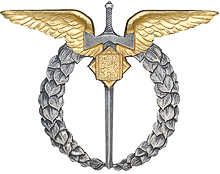


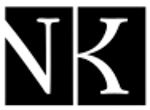

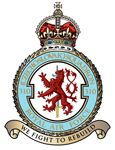
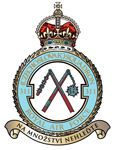
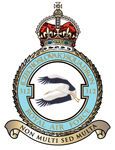
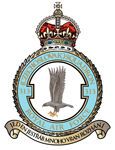


Some photos taken during an unveiling of Šiška’s memorial plaque in Lutopecny on 11th november 2011: http://www.czechspitfireclub.cz/?sekce1=fotogalerie&gal=111111.
Good article. Just one amendment if I may: The squadron which bears my late father’a name, is actually 222nd “ŠIŠKOVA” Training squadron.
Kind regards
Dagmar Johnson – Šišková
Hi Dagmar
I’ve just finished reading your father’s story (the book Flying for Freedom) … I have spent 20+ years searching for my maternal grandfather whom my mother never met (nor me) and have recently found him alive at 97 years old and living in Seattle! He is called Frank (Frantisek) Bret and flew with 311 Squadron. From your book, I learnt that you live/lived in Cumbria and i just wonder if you still do? I live in Lancaster and would love to meet.
Thank you for your dedicated work translating your father’s words and making them accessible to more people.
Tracey.
Very moving story.